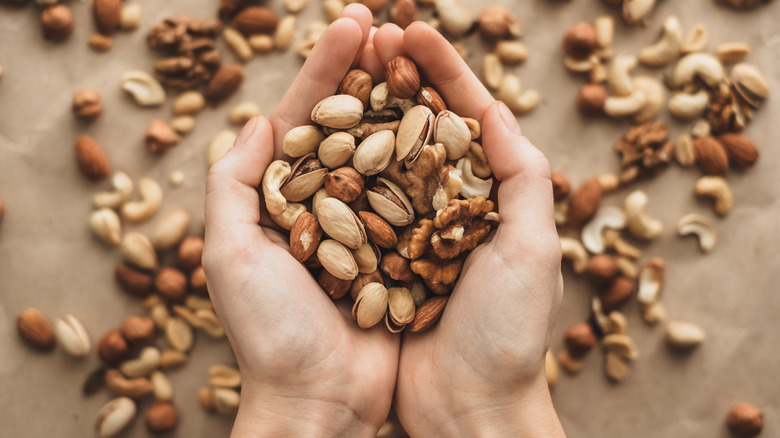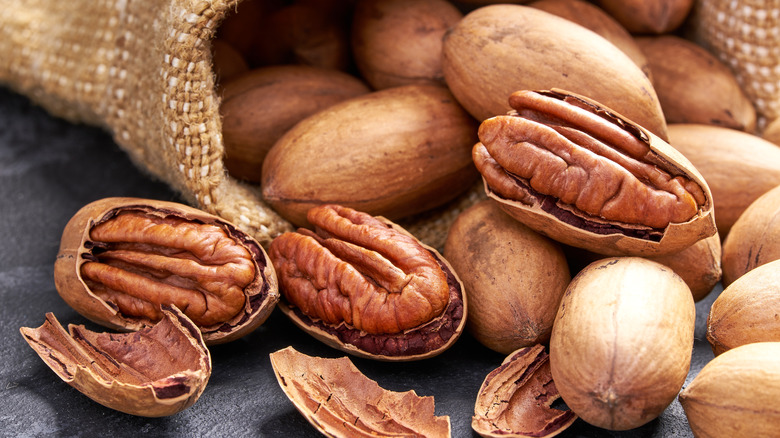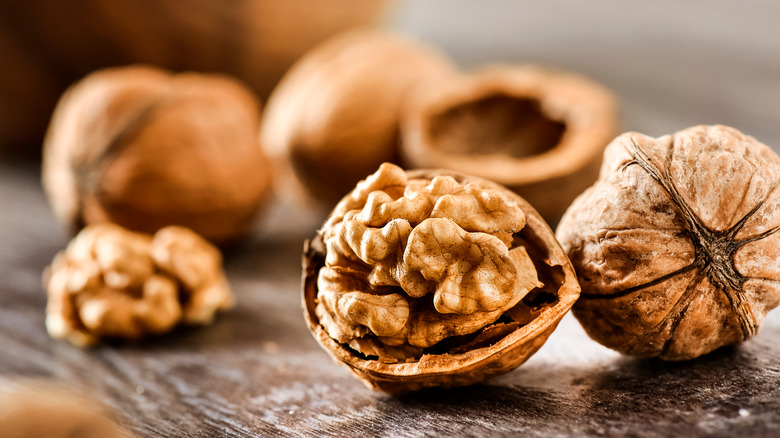What's The Difference Between Pecans And Walnuts?
If you have ever confused a pecan for a walnut, you're not alone. Though the two look similar, there are a few key differences between these common nuts. Upon closer inspection you may notice that pecan shells are darker, more oblong, and harder to break open than walnut shells. If you look inside the shell, you will see even more differences. Walnuts are larger and brain-shaped, while pecans are smaller, halved, and straight with a central fissure.
There is also a difference of price between the two nuts. On grocery store shelves throughout the U.S., you may find that walnuts are more expensive than pecans, while (according to Foodstruct), this would not necessarily be the case in Europe or Asia. While you probably won't have trouble finding these nuts at a supermarket near you, according to the Economic Research Service, as of 2015, Georgia was the leading U.S. producer of pecans, while Nutrition Outlook notes that California produces most of the country's walnuts.
If you are just nuts about pecans or walnuts, there are more differences between the pair that you should learn.
Harvesting pecans and walnuts
Like a lot of things we eat, pecans and walnuts look a lot different by the time they get to our shopping carts. Initially, black walnuts have a yellow-green husk and grow to about two inches wide. As they age, the husks turn dark brown, and when they fall to the ground, that means the nuts are ready to harvest. But beware — Farm and Dairy warns not to be so quick to pick these up bare-handed! Black walnuts are capable of staining your hands and clothing for days. The outlet recommends wearing gloves when handling.
Though pecan trees, at an average of 70 to 100 feet, can be much taller than walnut trees, most average 70 to 80 feet say The Kitchen Community, which means harvesting pecans isn't necessarily harder. In fact, harvesting pecans can surprisingly be much simpler. Pecans, like walnuts, also form inside a green husk that eventually turns brown but, unlike walnuts, these husks stay attached to the tree, crack open, and the nuts drop to the grown — no careful handling required!
Sampling and cooking with pecans and walnuts
Is it nutty to pay more for walnuts? Well, that depends on what you are looking to achieve. Though the two nuts share the same family of trees, according to The Kitchen Community, they don't taste the same. Pecans are sweet and chewy, but as they warm, they become richer in taste. This versatility makes pecans a good fit for sweet dishes like — you guessed it — pecan pie, as well as more savory (or even spicy) dishes, like pecan-crusted fish or chicken.
Walnuts, on the other hand, are earthy, bitter, and buttery. They are often found in sweeter recipes like granola, cookies, and muffins; but (like pecans) can also appear in savory dishes. If you are looking for some drool-worthy walnut dishes, why not try this walnut-studded zucchini bread, hearty cowboy cookies, or even a Waldorf salad?
The 'nut-rition' of pecans and walnuts
If allergies are on your mind, then you should know that one of the eight most common food allergies among Americans is an allergy to tree nuts. Both pecans and walnuts fall under this category. The good news is that just because you are allergic to one tree nut does not necessarily make you allergic to all of them (via American Academy of Allergy, Asthma and Immunology). If you are lucky enough to be free of allergies to pecans and walnuts, then there are some health benefits to munching on the tasty nuts.
Much like their appearance, according to Millican Pecan, the health value of pecans and walnuts are quite similar, and they both provide high amounts of unsaturated fat without any cholesterol. Pecans have the upper hand in some areas: they have slightly less calories, more vitamin E content, and a little more fiber than walnuts. But walnuts win when it comes to packing a protein punch (via Millican Pecan). Walnuts are also champs when it comes to antioxidants, according to Time, and contain more than you wouldd get from other nuts, including pecans.
When it comes to pecans and walnuts, we know you willl probably prefer one over the other, but you would have to be nuts not to at least take a crack at both. You will just have to find that perpetually lost nutcracker of yours!



